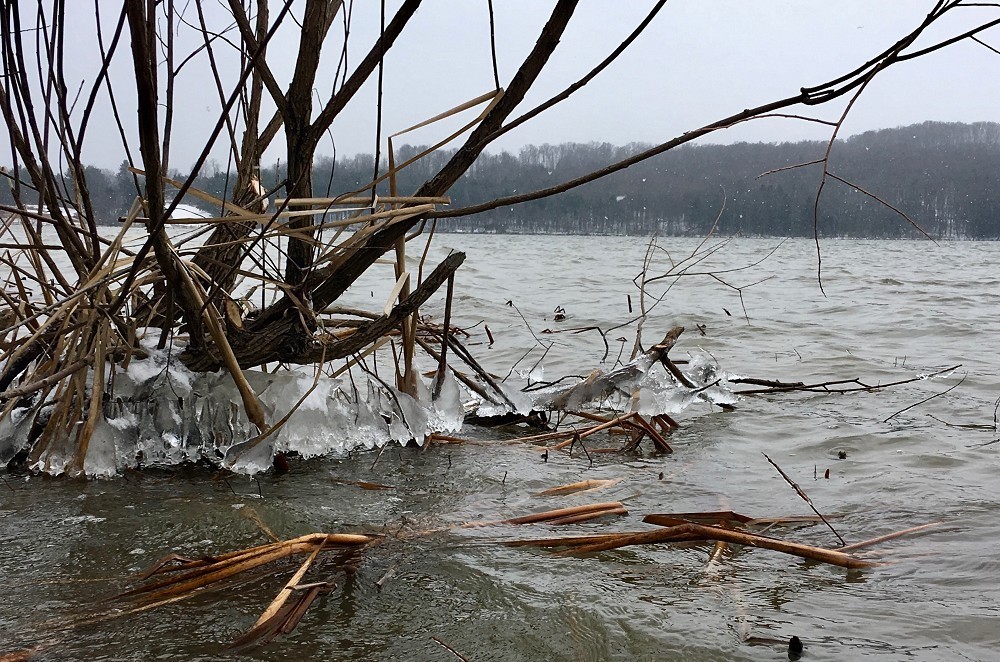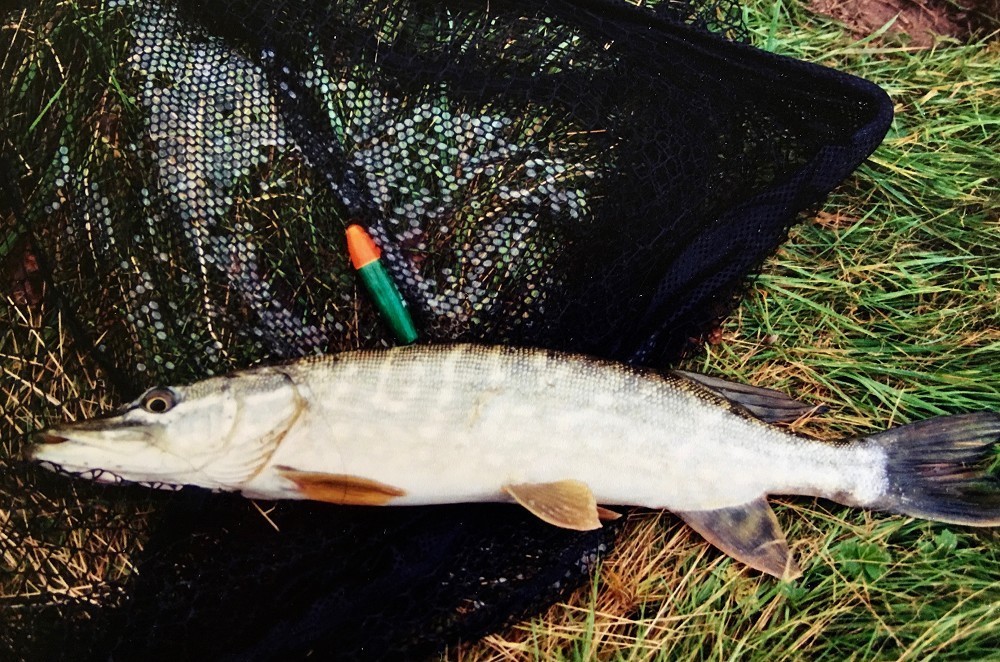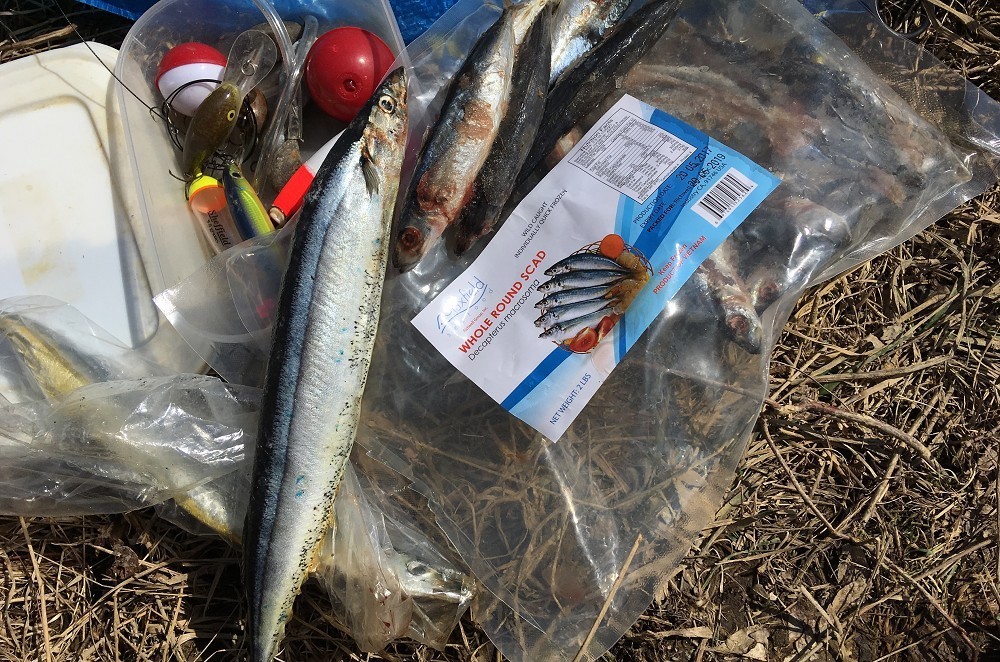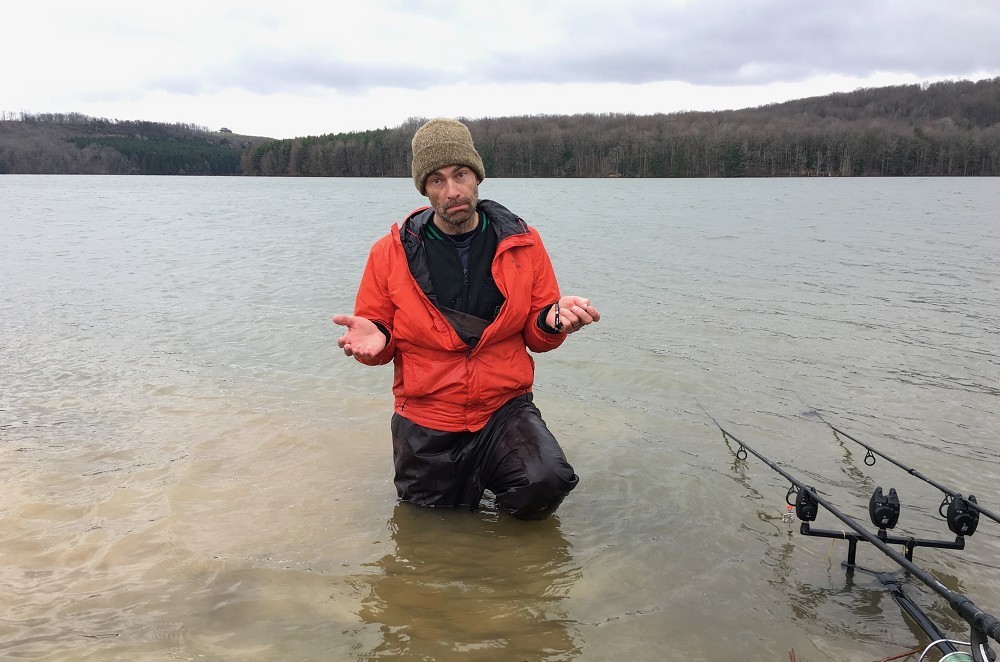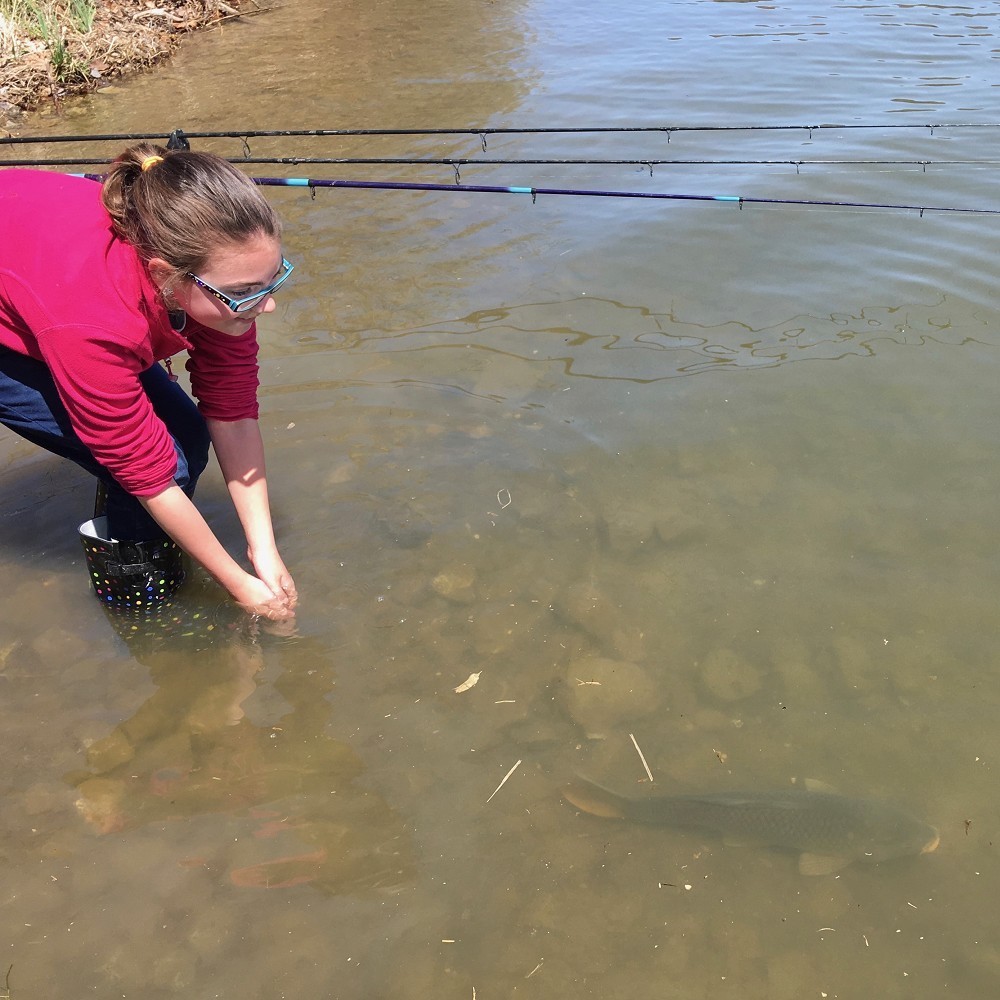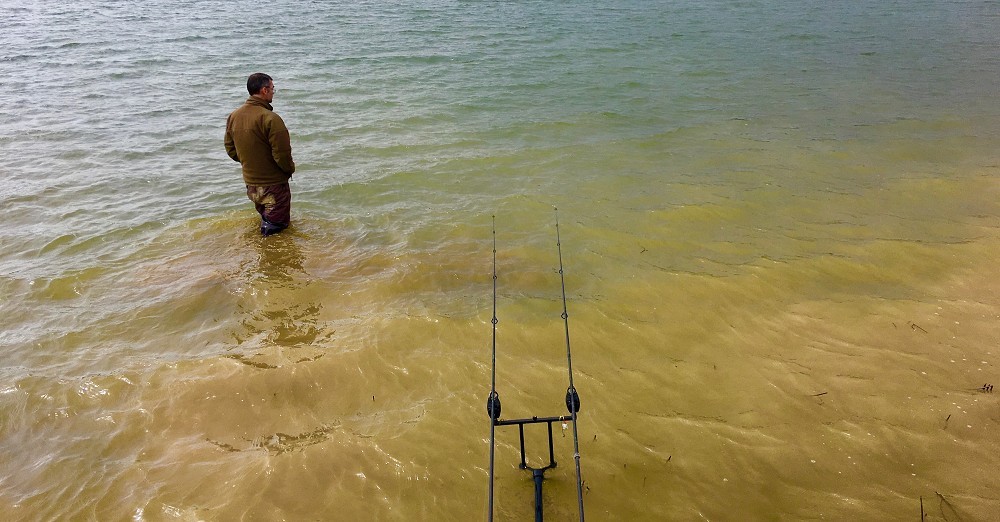
Not Carp Letter from America: April 2018
Simon Blanford and Andy Bell let us know what they've been up to this month...
"April is the cruelest month, breeding lilacs out of the dead land, mixing memory and desire, stirring dull roots with Spring rain.” T. S. Eliot may have had other reasons for citing April's cruelty but from a carp anglers perspective here in the north-east of the United States of America, April can be a real bastard. We had a week of surprisingly mild weather in March during which we fished. But it was a brief interlude. More usual March weather soon followed in the shape of freezing temperatures and snow. Intermittent thaws and wet deluges were followed by even more snow at the beginning of April, then two days with temperatures hitting 25oC before another frigid week where the ice that formed overnight on Simon's small garden pond would not melt through the following day.
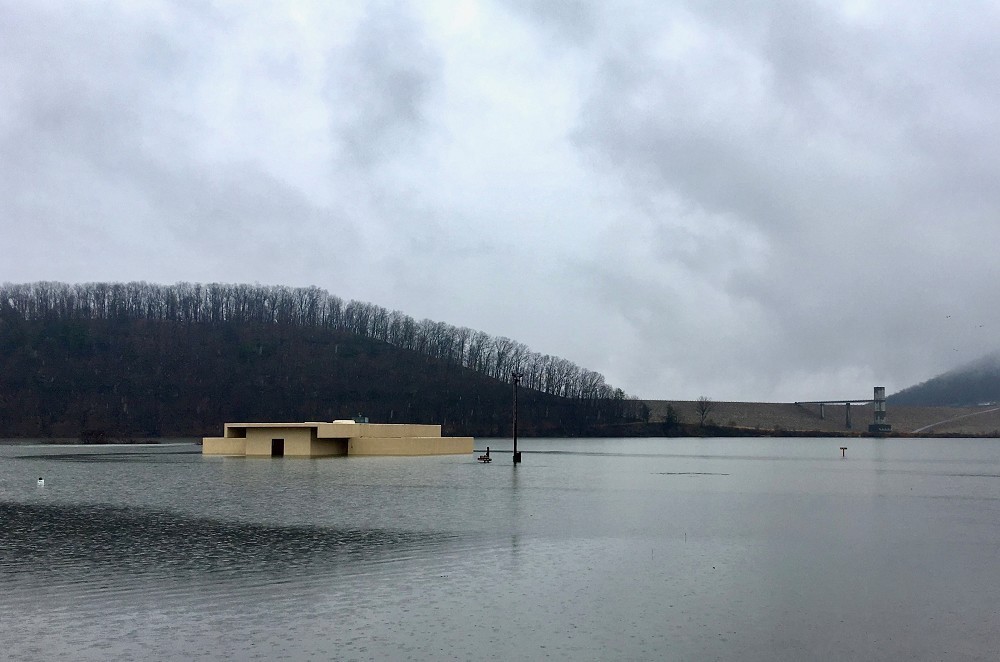 A bank-side convenience on a new lake. Though not quite so bank-side during the Spring thaw. Nor very convenient come to thing of it.
A bank-side convenience on a new lake. Though not quite so bank-side during the Spring thaw. Nor very convenient come to thing of it.We have become used to such changeability just at the time we are beginning to dust off the tackle and think about addressing the water. We are also used to putting up with a number of early season blanks eager, as we are to hit the water even if the carp are still very much comatose. This year however, and as we mentioned at the end of last month’s CLfromA, we have hatched a cunning plan. If it’s unlikely that any carp are going to be interested in our baits for much of the month we won’t even bother fish for them. We shall fish for not-carp instead. Given that we come from England and the range and habits of the vast majority of other American fish are a mystery to us the not-carp in question can only really mean one species - pike. What season opening quarry could be better. If it’s too cold for carp to be on the move the same is not the case for the lean, mean Esox. Pike are knee-jerked into action at this time of year by the slowly warming temperatures and increasing day length so they can fulfill their cold, carnal desires by congregating in the shallow, weedy bays and doing their bit for the next generation.
Of course we got it wrong. Going out in that mild week in March turned out to be a hideously early trip. We had misjudged the onset of the spring peregrination of pike in these large, deep, cold lakes. In England, they may have already been heading into shallower water, the males in train to their larger consorts. But here they were still deep-water somnolent and the fishing trip an exercise in hope rather than any expectation of reward. Returning home and a quick browse of the intertubes indicated that pike here move into the shallow bays when the water temperature reaches “about 40F”. This tends to happen around the middle of April. So we were a whole month early. No wonder the few people out walking their dogs gave us odd looks. A recce a week later coincided with more usual March weather: snow and wind with ice throughout the margins.
Our ill-judged first trip of the year might indicate a lack of knowledge regarding the ways of pike. It’s true that Andy's experience with these fish is a little limited. Aside from a spell on Loch Lomond sampling fish parasites (no, really) he was a dedicated match angler in his formative fishing and pike were nuisance animals. Those that charged in to disturb his carefully created swim, carefully created over an hour of drip feeding pinkies, squats or bloodworm so that he could pip his nearest rival by a couple of drams with a net full of bleak, were roundly despised.
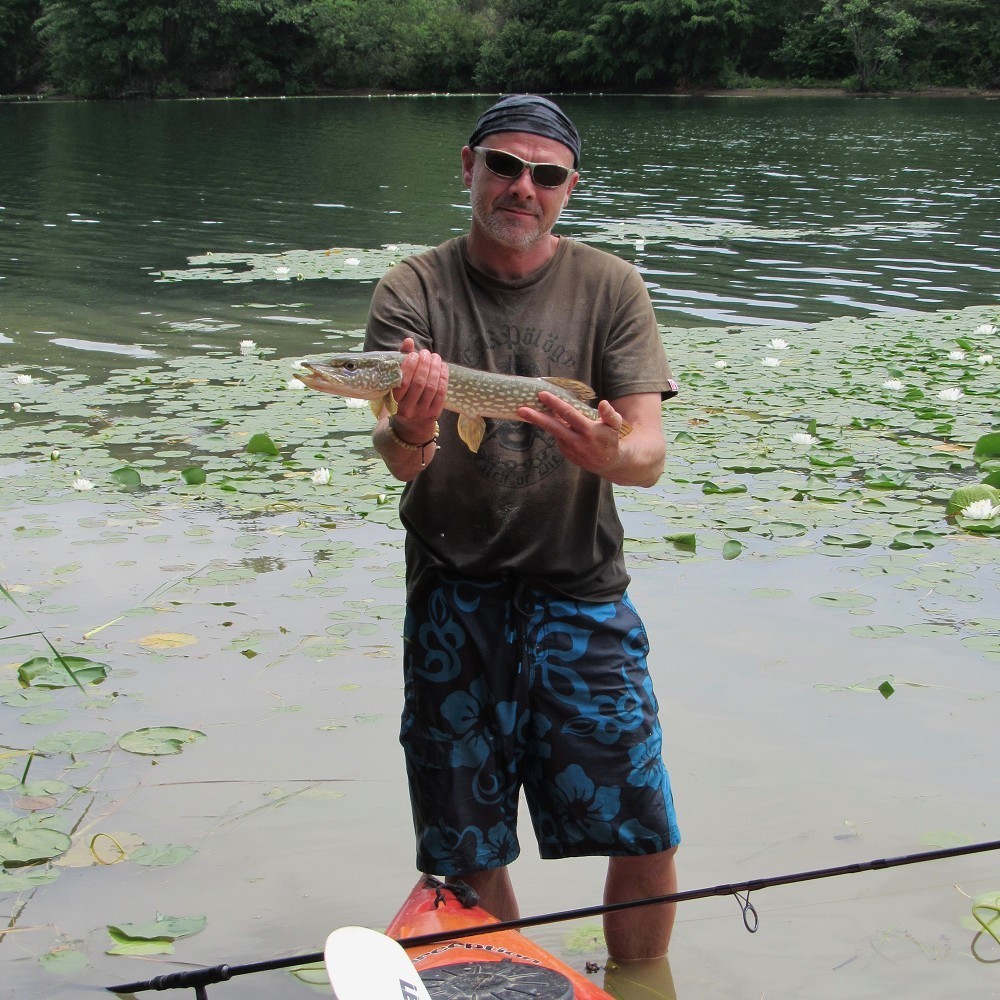 Andy’s idea of effective tactics pike produced this monster last year - fast retrieving a pink pop-up’s the method.
Andy’s idea of effective tactics pike produced this monster last year - fast retrieving a pink pop-up’s the method.Simon has no similar excuse. For him pike had a much more significant status. At one stage he had more pike titles on his shelves than any other single species book. There was Fred Buller’s, “Doomsday Book of Mammoth Pike” (the copy now broken-spined and loose-leaved) and “Pike and the Pike Angler”. Then there was Bailey and Page’s “Pike: The Predator becomes the Prey”, Bill Chillingworth’s “Tactics for Big Pike”, Barrie Rickards “Big Pike”, Neville Fickling’s “Pike Fishing in the Eighties” with that iconic image of the young Neville stretching out that long, lean pike against a wintery background of puddling water and churned mud. Simon’s favourite though, amongst this incomplete list of better known names, is a small, idiosyncratic offering written by a family friend (one of whose son’s is a famous maker of split cane rods), “Spinning for Pike” by R.C.R. Barder. Because of this influence Simon’s early piking involved much use of the Mepps Aglia Long (No. 4) and Jim Vincent’s shallow running spoons, the latter developed many moons ago for the Norfolk Broads. Then came the discovery of that acme from the plug catalogue, the ABU Hi Lo (with the adjustable front diving vein - Simon had an articulated version painted like a baby pike) closely followed by the Big S series by Shakespeare. Gradually, wobbled deadbaits (locally caught rudd and fishmonger bought sprats) replaced the hardware and then, as Simon’s wings spread to larger waters, the ubiquitous half herring, joey mackerel, smelt and, his dead fish of choice, the soft sardine. Simon’s never caught anything big, is still waiting for his first twenty, but he does remember with fondness those bleak winter days down on the drains, leaping frogging his rods every half an hour hoping to fall onto a pack of feeding fish. He even still has his original Bob Church one-piece, quilted, … what can we call it - boilersuit? It was de rigeur back in the day. Now it hangs somewhere in the back of a cupboard, smelling quietly of damp English winters.
Over here American’s appear peculiarly ambivalent about pike. Which is something of a surprise because, as we’ve said before, the American fishing scene has forgotten more about lure fishing for predatory fish than the UK has every learnt. It’s surprising then that pike are not more apparent in anglers' chat, not more obvious in the tackle makers minds and adverts. That might simply be because there are more predatory species to choose from here in the US. In the UK we have the humble perch (the European perch, Perca fluviatilis). The US has a perch too, the yellow perch, (Perca flavescens - though they look much the same to our untutored eye). The UK can add the diminutive Ruffe to the perch family present in the island’s waters as well as the introduced zander. But that’s pretty much it. Here In the US the perch family is considerably larger and includes (deep breath): white perch, pumpkinseeds and bluegill; green, redbreasted and redear sunfish; black and white crappie; rock, large-mouthed, small-mouthed, white and striped bass as well as sauger and walleye and then a host of other perches most too small to bother anglers. The pike is the sole esocid in UK waters. Not so here. Here there are pike, the same species as our Esox lucius - though they are often called northern pike, or simply, ‘Northerns’. Why they have to give them a hemispherical moniker as if there’s a southern pike (there isn’t) is beyond our understanding. But in addition there's also the famous muskellunge as well as chain, grass and redfin pickerel - a group of perfectly pike-formed, but considerably more diminutive fish.
Given the variety of fish-eating fish to target, pike only seem to draw real attention in the depths of winter and then from that peculiar species, the ice fisherman. Muskellunge are much more popular as the 'big' predator, the rest of the fishing elbow room being taken up by bass. So it wasn't that surprising to find we had most of the lake to ourselves when we returned mid-April to see if we could winkle out a fish or two from a large, shallow bay. Andy was itching to have at the carp, the pike being more of a sideshow for him, so committed two of his three allowable rods to targeting a small bay on the off chance that any cold-hardy, early movers might want a bit of sun on their backs. Simon set up all three of his rods for the toothy not-carp and we both employed the usual ledgered and float-ledgered dead fish tactics.
This despite the case that deadbaiting is not a tactic at the forefront of pike or muskie fishing here. It is used for pike but not quite in the same way and not as much a go-to tactic as it is in the UK. For muskies the received wisdom is that using deadbaits is a waste of time, they much prefer to attack live fish. Given the close nature of pike and muskies - their very similar feeding behaviour and diet range and the fact that they are separated each into their particular niche more by temperature (muskies prefer warmer water) than anything as tangible as feeding habits - snubbing the use of deadbaits for them is a curious piece of angling lore and one that certainly deserves to be tested. Aside from this, the lesser importance of using static deadbaits as a frontline tactic means that acquiring some sea fish proved a bit of a challenge. Tackle outlets had small, salted things that we weren’t even sure were real and supermarkets were no good unless we wanted to pay through the nose for red snapper. Eventually the winning shop proved to be the ever reliable oriental market and though they didn’t have sardines, smelt or herring they did have a sprat like scad and a bag of what were labeled ‘Mackerel Pike’ but looked more like blunt-nosed gar and is in fact the Pacific saury, unrelated to mackerel. Still beggars can’t be choosers so in for a cent, in for a dollar we snapped them up.
Nothing happened in the morning calm but in the breezy chop of mid-afternoon Simon’s alarm squealed, line was pulled from the reel and then as he was hastening to the rod, everything tightened, the rod tip pulled round before springing back slack. The pencil float dipped and bobbed thirty yards out on the lumpy water. Simon, thinking the pike had stopped to turn the bait wound down fast to tighten up. And wound down. And wound down. In came a slack line attached to nothing at all. Out on the water the float still bobbed. Somehow the line had been caught on an underwater obstruction, pulled tight and severed. The fish (undoubtedly a huge pike) had felt the resistance and ejected the bait. Simon used a spare rod to cast over the float and retrieve the rest of his tackle, mackerel pike still on the trebles. A strange occurrence.
A final session on the cusp of the spring finally arriving found Simon return to the bay for another bash. It snowed all day. Oddly Andy had been waylaid by work. Nevertheless, and in the early afternoon Simon had a run. This time all went well and he wound down and tightened into a fish that had taken his popped-up ‘mackerel’ section. A few shakes of the head later a fish of around eight pounds was in the net and promptly unhooked. Simon, realising that Andy would want some sort of photographic evidence, sacked the fish, set up the camera, got the fish back out of the sack, and promptly dropped it into the water - his once matter-of-fact handling of pike forgotten in the twenty something year interlude since the last one was banked.
"You numpty" Andy said, succinctly summing up his opinion of Simon's fish handling skills after being told of the events.
But have no fear. Though we may be absolutely shite at catching not-carp, we have been, as the month finally warmed up in its last week, better at catching not-not-carp. Or more simply, carp, if the double negative causes too much confusion.
But to read about that and the rest of our May exploits on The Lake, The Other Lake, The Little Lake, The Big Lake, The Local River and other evocatively titled waters you'll have to sit on your hands until next month’s CLfromA.



